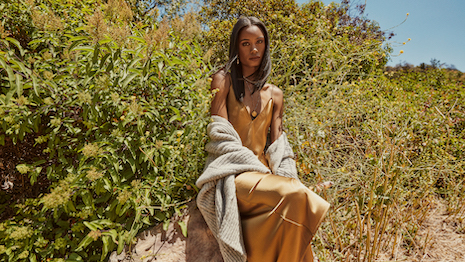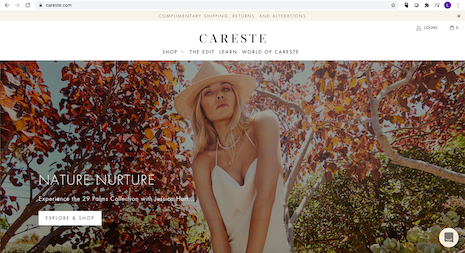 Slipdress from Careste, a made-to-order fashion brand with a direct-to-customer model. Image courtesy of Careste
Slipdress from Careste, a made-to-order fashion brand with a direct-to-customer model. Image courtesy of Careste
Bold and gutsy, but that is what can be expected from Celeste Markey and Elizabeth Rickard Shah as they officially roll the welcome mat for their direct-to-consumer, sustainably-focused fashion label, Careste.
Indeed, the two found this COVID-19 era to be the perfect time to introduce a sustainable made-to-order brand with a zero-inventory business model. Based in San Francisco, Careste targets women with shirts, dresses, caftans, camisoles, tunics, tops and blouses in clean, modern looks across 21 microsizes.
“There is no one in the luxury fashion landscape doing quite what we are doing for women's clothing,” Ms. Markey said.
“The other made-to-order businesses that have gained traction are a much lower price point, for menswear, and are for much more basic and simple designs,” she said.
 From left: Careste creative director Elizabeth Rickard Shah and founder/CEO Celeste Markey
From left: Careste creative director Elizabeth Rickard Shah and founder/CEO Celeste Markey
Both Ms. Markey and Ms. Rickard Shah have roots in fashion and luxury, spending a combined 40 years working at brands such as Giorgio Armani, Sonia Rykiel and Bulgari.
Now, two years after a soft debut, Careste is ready to face the market.
The company is supporting local community causes as part of a philanthropic push as well as pressing the foot on marketing and PR through a campaign featuring models Jessica Hart and Destene Kinser.
Here, in this interview, Ms. Markey and Ms. Rickard Shah spell out their plans and vision for Careste going forward. Please read on:
Careste – now that is an interesting name. Why?
Celeste Markey: Naming a brand is really important, and difficult.
Ultimately we worked with an excellent team to come up with Careste, which is actually a combination of my name and my daughter’s name. Celeste + Charis [which is pronounced with a hard C] = Careste
Is this the official coming-out for Careste?
Celeste Markey: It is. We launched softly in 2018 in beta form with a collection of pristine made-to-order shirting.
Careste's premise is built on offering made-to-order apparel for women through ecommerce with a sustainable bent. What was the thinking behind that unique combination?
Celeste Markey: Sustainability is one of our brand promises.
Everything we do begins with that in mind. By making products individually and on demand, we are able to eliminate all of the excess waste created in the industry by mass production, creating a new, sustainable business model.
Who is the target?
Celeste Markey: We are creating clothes for the modern luxury customer who is focused on making better, more informed and thoughtful choices in every aspect of her life. She’s educated, socially aware and effortlessly chic.
What type of merchandise are you starting out with? And where do you want to expand in terms of the product offering?
Celeste Markey: We have added a robust collection of shirting, including the Cornerstone Collection that gives back, and breezy summer staples such as caftans, slip dresses, wrap dresses, backless halter silk tops and more.
 Caftan from Careste. Image courtesy of Careste
Caftan from Careste. Image courtesy of Careste
Officially launching the brand during the COVID-19 pandemic is bold. Why this timing?
Celeste Markey: Inventory is not only costly but it is wasteful, and COVID wreaked havoc on these traditional supply chains when brands were forced to cancel orders from their factories, leaving literally millions of unfinished pieces on the ground and therefore saddled factories with debt and inventory.
Careste solves this age-old and recurring problem by making only what consumers want.
After a soft launch and much success behind made-to-order shirting, we had plans to launch an extended collection in our pipeline.
With so many shifts in our industry and new focuses on zero-inventory business models these past few months, we received a lot of interest in launching this expanded collection now, from both existing and potential consumers, as well as investors looking at new business models with increasing relevance post pandemic.
What makes Careste different from its competition? Which competitive set does the brand fall in?
Celeste Markey: There is no one in the luxury fashion landscape doing quite what we are doing for women's clothing.
The other made-to-order businesses that have gained traction are a much lower price point, for menswear, and are for much more basic and simple designs.
The COVID-19 pandemic has shown that just-in-time fulfillment may be tricky if the supply chain is disrupted. And yet Careste is based on that model. Is that not a bit risky?
Celeste Markey: We are finding the exact opposite to be true.
Because we are nimble and able to manufacture on a much shorter development calendar, everything is moving smoothly.
Delays for us are minimal and we are only producing as orders come in.
Our factory is very pleased that we are the only brand continuing forward with daily orders, and no cancellations.
Our customers are pleased that they are able to contribute to a more sustainable business model that actually solves the problem that all other brands and manufacturers are dealing with now.
What was the thinking behind your rollout merchandise and the new 29 Palms Collection?
Celeste Markey: 29 Palms was designed for the way we are currently living. In our homes, for effortless and elegant ease.
We were able to design this collection after COVID restrictions began and launch it in time for consumers to shop and enjoy it.
29 Palms portrays a lifestyle that evokes relaxed sunny days spent sipping rosé around a pool or in a garden.
There is a sense of freedom when wearing our pieces from 29 Palms.
Where are the clothes made?
Celeste Markey: We have a global supply chain, with manufacturing partners between Europe and China.
What type of marketing and social push are you deploying?
Celeste Markey: Through our launch campaigns featuring Australian model Jessica Hart and Black model, Destene Kinser, along with our Careste community, we have attracted a lot of attention, both from the press and consumers alike.
We will continue to partner with sustainable focused brands and influencers who are excited to organically support Careste and this new shopping experience, that is super relevant at this time.
Any plans to open retail stores?
Celeste Markey: We are currently focused on partnerships, continuing to grow our Careste community and give back initiative, as well as product category expansion.
Perhaps when the time is right, it is something we will consider.
Apparel has a high return rate, in some cases, 40 percent. Is made-to-order one way to cut back on returns? And if returned, how do you process that merchandise keeping in mind safety protocols?
Celeste Markey: You are correct. By making items individually in our size range from 00-20, we are able to accommodate all body types and significantly reduce our return rate.
We are currently working with an international partner on a program to reuse our returned items and samples, which would make Careste completely circular.
 Careste homepage. Image credit: Careste
Careste homepage. Image credit: Careste
Both of you have experience working for luxury brands. What do you bring from your careers to the new business? And what have improved based on your previous experience in terms of product, marketing, merchandising and management?
Celeste Markey: We have both been shaped by macro events, including the 2008 financial crisis and now COVID and the immediate implications of the supply chain disruption and over-production.
We are also struck by how much the luxury consumer has changed in light of these events.
We are creating for a very educated, enlightened consumer that values aspiration as much as approachability.
How do you divide responsibilities? Or are you often playing in the same sandbox?
Celeste Markey: Elizabeth and I collaborate on pretty much everything, but then we do dive into our areas of expertise.
On a daily basis that could mean working through the upcoming collection together, and I will go and focus on the go-to market strategy, the financial model and forecast, marketing and Web site.
Elizabeth would focus from there on bringing the collection to life through design specifics, product development and various other elements with the factories including fabric selection, costing, sourcing and more.
Who are your role models?
Celeste Markey: My parents, grandparents and my blended family, inspire me daily. They taught me how to endure life’s challenges and have modeled poise, perseverance and strength in the face of adversity.
Elizabeth Rickard Shah: Same. My parents, my in-laws, who are amazing because they left everything behind when they came to the U.S. from Kenya and have built a successful lifestyle and maintain a close, loving family.
Both my husband and I come from a legacy of entrepreneurship, which has also guided my choices.
Where would you like to see the brand in a year's time?
Celeste Markey: We're excited and hopeful of building an internationally recognized, new luxury brand that supports innovative design and sustainability in our industry.